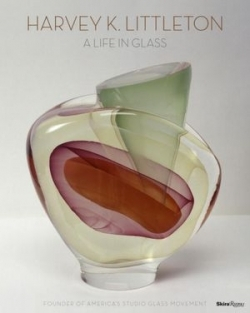It looks like you've stumbled upon a page meant to be read by our code instead of viewed directly. You're probably looking for this page.
Harvey K. Littleton
A Life in Glass
The arrival of 2012 marks two milestones in the studio glass movement: the ninetieth birthday of Harvey Kline Littleton, and the fiftieth anniversary of Littleton’s seminal glassblowing workshops at the Toledo Museum of Art. As a child born to J.T. Littleton—director of research and development at Corning Glass Works and a mastermind behind the invention of Pyrex—young Harvey grew up hearing much ado about glass. Even a simple bowl of jello prompted vitreous abstractions at the dinner table, as J.T. methodically divided and dissected the gelatin to illustrate how glass can shatter and break.
Harvey would ultimately take his birthright passion and make it his own, starting with a 1942 neoclassical female torso cast in multiform glass and continuing with fascinating experiments that elevated the medium to an expressive entity. As Littleton unhappily observed in 1959, though glass was once part of the vibrant artistic mainstream, somewhere along the line it had become exiled to “semi-industrial catalogue items as uniform as peas in a pod.”
Biographer Joan Falconer Byrd first encountered Littleton when she enrolled in his early 1960s glassblowing workshop at the University of Wisconsin, and her decades of association with the artist offer an intriguing glimpse of what has truly been a “life in glass.” Beyond Littleton’s honored and exhibited professional career, we learn of his service in World War II, his marriage to Hawaiian painting student Bess Tamura, the conflicts with his science-minded father, and, of course, Littleton’s quest to manifest creative visions. Fortunately, many of Littleton’s visions were made manifest, as seen in the book’s beautiful color photographs of the artist’s glass and ceramic pieces and their collective development over the years.
The scope of Littleton’s career is further paralleled by Byrd’s inclusion of contemporaries and collaborators such as Erwin Eisch and Dominick Labino. There are also featured works by Dale Chihuly, another of Littleton’s students, who asserts that his own famed path most likely would have gone off in a non-glass-related direction if not for “Harvey’s influence.”
From lyrically arching pieces to colorful suspensions or inventive vitreographs, Harvey Littleton has given glass the same power as painting or sculpture, yet with a further elusive and transparent dimension. Byrd notes that when she first met Littleton, she wasn’t fully
able to comprehend the intensity he felt toward the true potential of glass. Her tribute to Corning’s native son demonstrates how she
has come to both share that passion and
communicate it to us all.
Reviewed by
Meg Nola
Disclosure: This article is not an endorsement, but a review. The publisher of this book provided free copies of the book to have their book reviewed by a professional reviewer. No fee was paid by the publisher for this review. Foreword Reviews only recommends books that we love. Foreword Magazine, Inc. is disclosing this in accordance with the Federal Trade Commission’s 16 CFR, Part 255.
